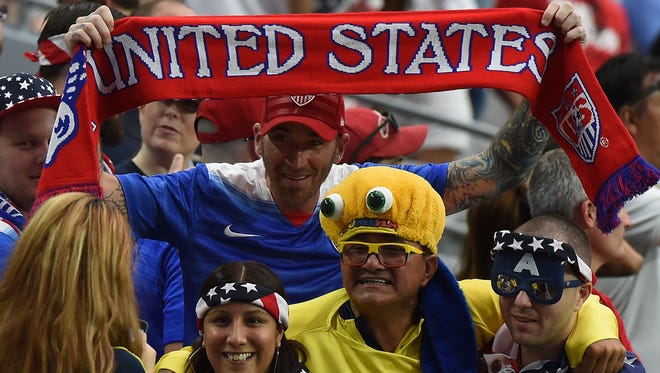We all need to scrap identity politics: Column
Both parties are dividing us into mini-tribes, but that ruins the greatest thing about America.

I stepped out of a shop in Venice, Italy, two months ago and had a light-bulb epiphany about Americans.
The typical Venetian pedestrian-only street was completely gridlocked. As I stood there stuck in a mass of people dressed mostly in jeans and T-shirts and speaking dozens of languages, I heard behind me three laughing guys who sounded like Americans. Turning around to give a thumbs up to my countrymen, I suddenly realized that it was impossible to recognize them by sight. Only when they started talking again was I able to identify the Americans — a college-aged, mixed-heritage trio of Asian, black and white.
There is no one American look anymore. We are a people of immense diversity. Since the 1965 civil rights law and the immigration law the same year that “changed the face of America” (the title of my newest book), we have had more than two generations of intermarriages among highly diverse races, ethnic groups, religious faiths, creeds and orientations.
Integration comes faster than ever before. “Multiracial Americans are at the cutting edge of social and demographic change in the U.S. — young, proud, tolerant and growing at a rate three times as fast as the population as a whole,” according to "Multiracial in America," a 2015 report from the Pew Research Center. In fact, "intermarriage rates among Latino and Asian newlyweds outpace those of whites and blacks,” Mark Lopez of the Pew Hispanic Center told me.
The biggest population group in the U.S. today is the “multi-everything” Millennials, whom I call the “whatever” generation. They are the most diverse population ever: multinational, multilingual, multireligious, multicultural, multi-ethnic and multi-family-background. Many researchers find that Millennials do not commit to almost any big brand, organization, religion, political party or even any identity for very long.
Trump can beat Clinton if GOP unites: Column
Our movies, TV shows and ads that are dispersed throughout the world recognize our unique American diversity. There is no longer a single “American” visual type. No one person or type can possibly represent all Americans visually. The world recognizes that, and is awed by it.
So why has the public narrative become increasingly divisive? When Donald Trump talks about "taking back our country," is he talking just about whites? And why do Democrats divide Americans into monolithic identity groups interested in single issues?
The 2012 nominating conventions highlighted some of the contrasts between the parties. I was at both of them, and they organized their schedules completely differently. The Republicans were split into state, regional and issue caucuses on social and economic policies. I was covering Latino delegates, and almost all of the Republican state delegations had Hispanic-heritage members attending. But they didn’t identify their interests by ethnic group. For instance, immigration was mainly about jobs — for Americans.
The Democrats, on the other hand, each day met in identity-group caucuses: the women’s caucus, the gay caucus, the Latino caucus, the black caucus (everything but a heterosexual white working man’s caucus). First lady Michelle Obama and senior White House adviser Valerie Jarrett scrambled from caucus to caucus — enveloped in Secret Service and gatekeepers — to assure each one of President Obama’s support for highly specialized interests: abortion for women, rights beyond marriage for gays, immigration reform for Latinos, civil rights for blacks.
#BlackWhiteBlueTogether: Churches try to bridge gap between police, community
POLICING THE USA: A look at race, justice, media
But where was the recognition of diversity within the so-called diverse caucuses? What about the majority of Latino voters whose top issues are the economy and education, not immigration; and mixed-heritage, college-educated minorities like President Obama who don’t think their children should be considered as affirmative action students? What about Asians, the fastest growing demographic in America, who are suing over alleged caps on admissions to U.S. universities?
We'll see next week whether the Democratic National Convention better reflects the diversity within our diversity. And we'll see this week whether the Republican convention shifts to a more inclusive tone.
Diversity in America is highly complicated and messy. It is understandable that political and media professionals want to simplify their messages and audiences. But by concentrating on the mini-tribes within our population, or by trying to pit them against each other, they are ruining the greatest thing about Americans — our ability as diverse individuals to identify and act as a dynamic whole. Emphasizing narrow identity group affiliations also impedes our ability to understand “the other.”
“The more we identify with singular groups, the less empathy we have towards others,” lawyer Wendy Kaminer warned last month at a conference sponsored by the liberal American Constitution Society.
Right now in this heated time of division, the identity we need to coalesce around is American.
Margaret "Peggy" Sands Orchowski is the congressional correspondent for the Hispanic Outlook and author of the 2015 bookThe Law That Changed the Face of America. Follow her on Twitter.
To read diverse opinions from our Board of Contributors and other writers, go to the Opinion front page, follow us on Twitter @USATOpinion and sign up for our daily Opinion newsletter.